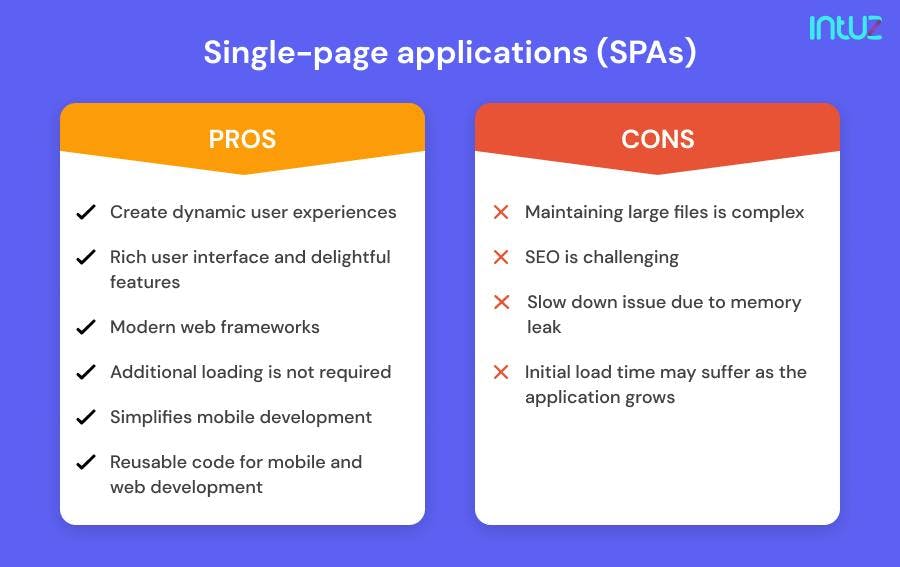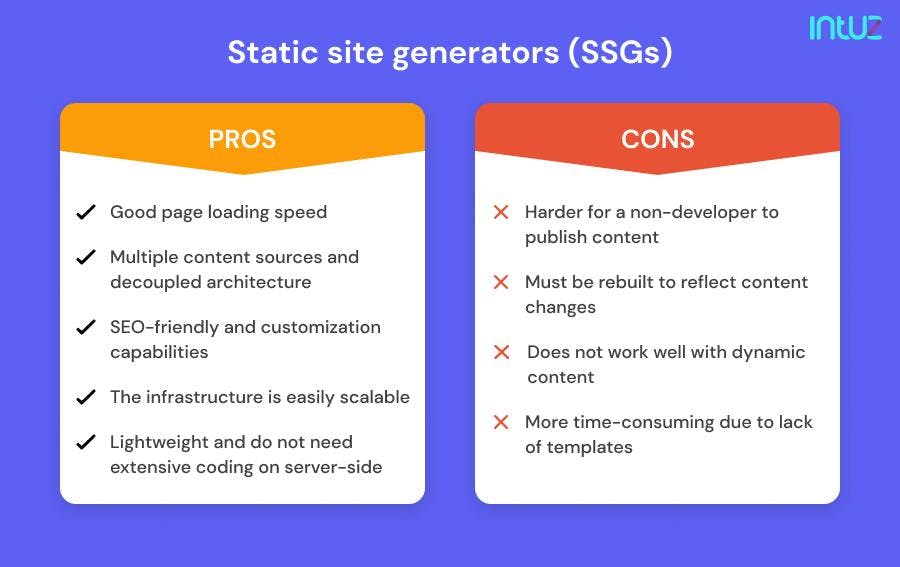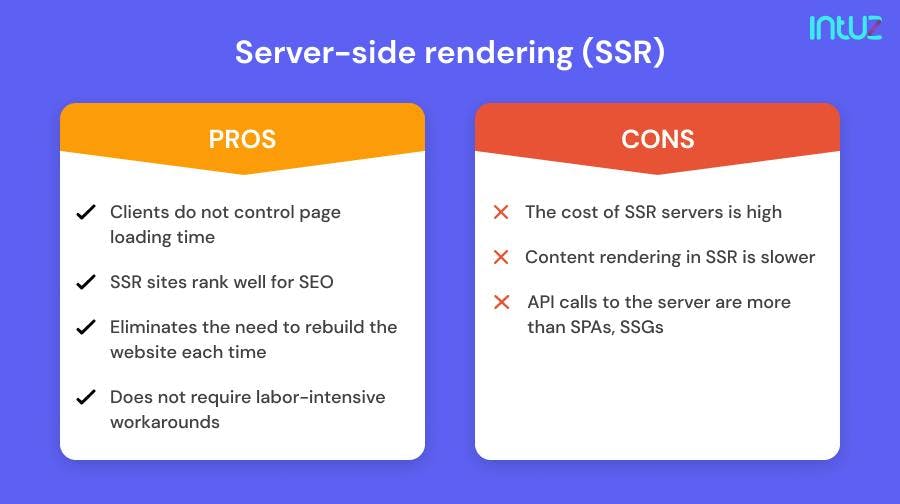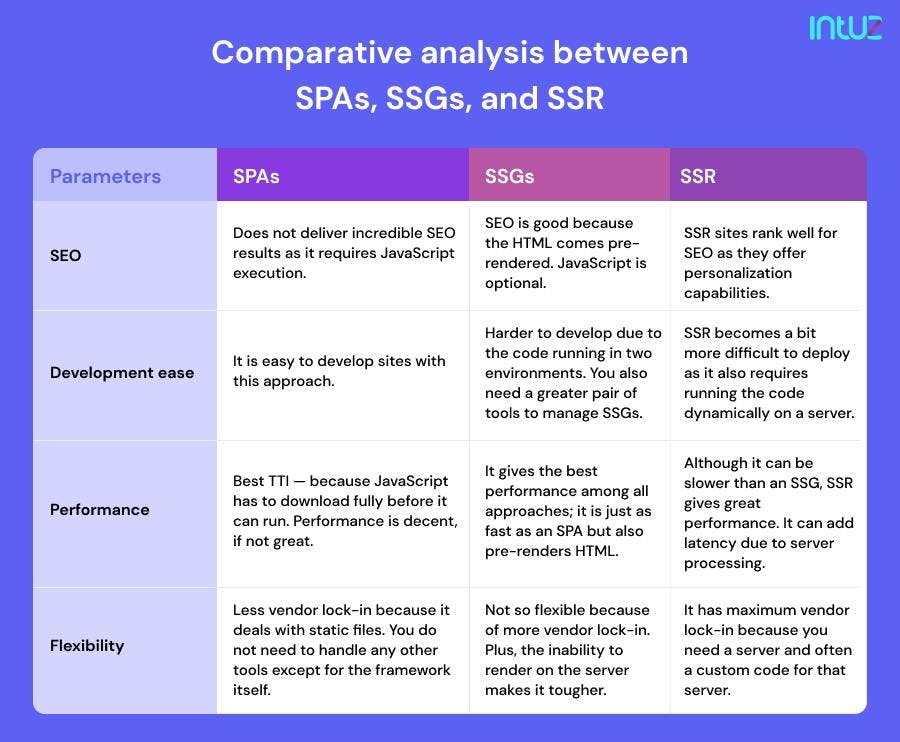Modern web experiences are driven by the basics of composable architectures, even though trends change every other year or so. You must have come across common words such as SPA, SSG, and SSR while building modern digital experiences.
Understanding the difference between SPAs, SSGs, and SSRs will help you make informed decisions when devising a strategy for your next project.
A glance at the strategies for application development
There are three strategies for JavaScript app development that can be useful depending upon your project needs. When using a JavaScript framework, the simplest approach is to make a single-page app (SPA). It works as a shell of HTML with a script to populate the web page's content.
Instead of populating all the content in the HTML file simultaneously, the browser is required to wait for the JavaScript to render code. An SPA uses React or Vue to load before displaying any content.
The concept is efficient as it generates only the necessary code for your application, thus taking up less file size and saving time. It is used by frameworks such as the Create React App, where a template is created to bundle JavaScript with an HTML skeleton.
An SPA cuts down the need to generate large-size HTML pages, allowing them to be used directly within a website or web application project instead.
However, as JavaScript loading takes time, it makes your website slow by loading sluggishly on slow networks. It impacts the user experience as some visitors may get agitated and bounce off your website.
Frameworks such as Next.js, SvelteKit, and Nuxt.js offer server-side rendering (SSR) and support static site generation (SSG). Similar to a traditional website, these frameworks deliver pre-built JavaScript when the server sends HTML to the client.
The application functions like an SPA upon loading the JavaScript, which is the main difference. HTML generation forms the primary difference between SSG and SSR websites.
In SSG sites, the HTML file is generated upon project compilation. It eliminates the need for a server as it uses static files.
However, you can customize the page with the SSR approach by generating the HTML upon each request. It requires a server but works without client-side JavaScript. In the following sections, we will learn each concept in greater detail and conduct a comparative analysis:
Everything you need to know about single-page applications (SPAs)
The rise of SPAs has led to a new era for web development. They render when the client requests them, and they are structured as a single HTML page with no preloaded content.
That means instead of loading all the data from Javascript files, an SPA adopts frameworks such as React, Ember.JS, Vue.js, Svelte, and AngularJS to load before the content gets displayed.
With the right technology, the page loading time can be reduced or eliminated altogether. SSGs and SPAs are both built with modern frameworks that enable code splitting.
It means some elements will load-on-demand, so you do not need to worry about your users being stuck on a sluggish website. With the technology, you can make the user experience seamless and quick as they navigate across a SPA.
An SPA offers the best Time to Interactive (TTI) (a metric tracked in the Performance section of the Lighthouse report). Still, it is not SEO friendly due to JavaScript execution before the search engine can process the content.
Pros
- The approach is excellent to create dynamic user experiences and a custom feel.
- With an SPA, you do not need to use extra queries to the server for downloading pages.
- It is the perfect choice for creating apps with a rich user interface and delightful features.
- An SPA gives control over the architecture and allows the use of modern web frameworks.
- The initial loading of the application may take time. However, additional loading is not required once it is fully loaded.
- It simplifies mobile development, and you can reuse the same backend for building both web and native mobile apps.
Cons
- Maintaining large files for complex web applications is challenging.
- SEO is challenging due to the lack of initial content on the HTML and its load time.
- Memory leaks in JavaScript are common, and that can cause a powerful application to slow down.
- The SPA approach requires workarounds, which can be very costly and time-consuming.
- The initial load time may suffer as the application grows in size and complexity, adversely impacting the user experience.

Use cases
The popularity of SPAs is on the rise because they provide a fluid web and mobile experience that can scale easily. Some examples wherein SPAs have been deployed include Gmail, Google Maps, Pinterest, Paypal, and Netflix.
Everything you need to know about static site generators (SSGs)
SSGs work differently compared to SPA. They help create static sites as they generate content when building new pages or updating content. SSGs do not depend on user requests and offer consistent content for users.
By including SSGs as a part of the tech stack, you can pull data from multiple data sources. Being among the modern approaches to web development, an SSG is suitable for building robust applications and websites where content personalization is not required.
SSGs work well with a headless CMS, a CDN, and a static hosting site. Webhooks trigger content changes and SSGs deploy the changes to the site stored in a cache.
On the other hand, pre-rendered HTML files are stored in locations that are geographically closer to the request using CDNs. That is how SSGs come in handy for reducing page load times.
In some cases, it could be slower than SPAs because of code duplication. But usually, that is just a one-off case. SSG sites load content faster than SPAs, as they do not need to download JavaScript to display content. The pre-rendered HTML with optional JavaScript makes SSG a good option for SEO-oriented projects.
Pros
- Pre-rendered and static content helps improve page loading speed.
- You can easily create multiple content sources and decoupled architecture.
- SEO-friendly and customization capabilities are unrestricted by any templates.
- SSGs promote the organic growth of the project as the infrastructure is easily scalable.
- Developers can create any template they want as they are not limited by fields provided by a CMS.
- Static websites are lightweight and do not need extensive coding to perform on the server-side.
Cons
- The site must be rebuilt to reflect content changes.
- It is harder for a non-developer to publish content using an SSG.
- The technology does not work well with dynamic content where personalization is paramount.
- Many SSGs do not come with templates, so the developers may have to spend a lot of time designing them from scratch.

Use cases
Static site generators such as Jekyll, Hugo, Gatsby, and Eleventy are helpful to create sites that do not require extraordinarily personalized or dynamic content. Forestry.io, Hartwell Insurance, Ruby on Rails, Frame.ai, and Netflix Devices are some of the examples wherein SSG has been deployed.
Everything you need to know about server-side rendering (SSR)
SSR is a significant breakthrough in web development technology that enables developers to provide dynamic content experiences. SSR is ideal for making personalized sites where live changes can be viewed and applied immediately, without the need to wait several seconds before any updates happen or being stuck with old information.
SSR is a type of web design in which content for each page must be pre-fetched from an external source and then rendered onto the server before being sent to the browser. The only flipside is that loading everything in real-time makes the application slower.
However, SSR ensures that any changes on the site are available immediately and in full detail without taking down the application for maintenance. The retrieved data can reside on demand to speed up the website through caching services such as Asset Pipe (a service that caches images) or even HTML5's localStorage object.
Web Application Architecture: A Comprehensive Guide On The What, Why And How
Learn NowSSR fulfills the time-sensitivity and customization requirements of applications, thus supporting large amounts of user interaction. You can easily apply content personalization through SSR in eCommerce ecosystems. The website's infrastructure can handle several requests and scale as your footfall grows.
Pros
- Clients do not control page loading time and quality.
- SSR sites rank well for SEO as they offer personalization capabilities.
- Instant display of changed content eliminates the need to rebuild the website each time.
- There are available contents for crawling the data on a search engine. No more empty <body> tags to deal with.
- SSR enables creating personalized experiences through dynamic content and does not require labor-intensive workarounds.
Cons
- The cost of SSR servers is high.
- Content rendering in SSR is slower than the other two approaches.
- API calls to the server are more than those with SPAs and SSGs.

Use cases
Server-side rendered sites are great for content that needs to be updated quickly and apps involving many user interactions. SSR works through frameworks such as Next.js, Razzle, Gatsby, and Nuxt.js. Netflix, npm, and Autho are famous website examples using Next.js to render React on the server-side.
Comparative analysis between SPAs, SSGs, and SSR
All three web development approaches are ideal in different scenarios. Depending on the performance delivered, flexibility, budget, and the developer's preference for fulfilling your project requirements, you can take a pick. Here is a comparative analysis:

You can decide based on the content and how you wish to make it available to your audience. To create a dynamic web experience, the best option is using SPAs with client-side rendering. However, the page load times and SEO are challenges of this approach.
SSGs, in comparison, enable quick static site building along with SEO capabilities — though it limits personalization options unless you perform some workarounds.
It may become a time-consuming and budget-exhaustive process due to which SSR might be a better option for such projects.
Over to you
None of the three app development strategies are wrong to use for your project. All you need to do is review your requirements and the three approaches before taking a call.
Since due importance is given to user experience, you must ensure that the approach enables you to build a solid and dynamic web application. At Intuz, we analyze your demands, plans, and requirements deeper.




